Oriental incense becomes your signature scent because it interacts uniquely with your body chemistry, creating a personalized fragrance that's distinctly yours. The complex blend of rare ingredients like oud, amber, and sandalwood unfolds throughout the day, revealing warm, spicy, and resinous elements that leave a lasting impression. With roots tracing back thousands of years through the Silk Road, these exotic fragrances offer a timeless appeal that's worth exploring for your signature scent journey.
Discovering the Timeless Appeal of Oriental Incense Notes

While many fragrance families come and go with changing trends, oriental incense notes have maintained their allure for centuries.
You'll discover a complex tapestry of warm, spicy, and resinous elements that unfold throughout the day, revealing new layers of depth with each passing hour.
When you wear oriental incense, you're embracing an exotic blend of rare ingredients like oud, amber, and sandalwood that create an opulent and distinctive presence. Experience the heritage of Ahmed Al Maghribi Perfumes, renowned for their exceptional oriental fragrances.
These notes don't just sit on your skin; they interact with your unique chemistry to develop a personalized scent that's truly yours.
Whether paired with citrus, floral, or additional oriental notes, the versatility of these fragrances allows you to express different facets of your personality while maintaining that unmistakable, sensual warmth that's become synonymous with luxury.
Historical Roots and Cultural Evolution of Oriental Fragrances
The enchanting allure of oriental incense fragrances traces back thousands of years through the winding paths of the ancient Silk Road.
When you wear these scents today, you're connecting with a rich heritage that once adorned religious ceremonies and royal courts across the Middle East and Asia. Frankincense and myrrh were especially prized for their sacred significance in these traditional rituals.
What makes these fragrances truly remarkable is their evolution through time and trade:
- Ancient perfume-making techniques from 1000 BCE Egypt still influence modern formulations.
- The Silk Road's extensive network transformed local scents into globally cherished treasures.
- Chemical advances in the 19th century allowed perfumers to create more sophisticated oriental blends.
You'll find that today's oriental incense fragrances masterfully blend this historical legacy with contemporary interpretations, offering you a signature scent that's both timeless and uniquely modern.
Essential Ingredients Behind Signature Oriental Scents

Signature oriental scents draw their distinctive character from a masterful blend of precious ingredients that have captivated perfume enthusiasts for centuries.
You'll find incense at the heart of these fragrances, extracted from Boswellia trees and prized for its warm, sacred aroma and stress-reducing properties. The addition of amber brings sweet, rich undertones that enhance longevity, while rare oud from Southeast Asian agarwood adds an unmatched depth and resinous complexity that's worth its weight in gold. The inclusion of delicate red saffron brings an exotic mystique and rare luxury to the composition.
Myrrh completes this aromatic quartet with its intense balsamic notes, featuring hints of licorice and woody undertones.
When combined, these ingredients create a sophisticated symphony that's both timeless and deeply personal. It's this unique blend that makes oriental incense-based fragrances so compelling as signature scents.
Mastering the Art of Blending Oriental Incense Notes
Creating your own oriental incense blend requires a deep understanding of how different aromatic elements interact and complement each other. You'll need to start with a base note, typically a resin like frankincense or dragon's blood, which provides the foundation and longevity of your signature scent.
When crafting your blend, remember these essential steps:
- Select no more than three complementary middle notes, such as cinnamon or patchouli, to maintain a balanced aroma.
- Sift all ingredients through a fine sieve to achieve uniform consistency.
- Add at least 10% makko powder to guarantee proper burning and binding.
Once you've combined your ingredients, you'll need to knead them into a paste with water, creating what's known as "Tama." This process requires patience and precision, as proper blending directly affects the final quality of your incense.
Creating Your Personal Oriental Perfume Recipe

Start your oriental perfume journey by selecting rich base notes like amber, vanilla, or tonka bean that resonate with your personal memories and preferences.
You'll want to layer these foundational elements with a careful balance of woods like sandalwood or oud, followed by spices such as cardamom or cinnamon that complement rather than overwhelm your chosen base.
Remember that your signature scent should reflect your personality, so don't hesitate to experiment with different combinations until you find the perfect blend that feels authentically you.
Choosing Base Notes First
Base notes form the foundation of your oriental perfume, much like a building's cornerstone.
When creating your signature scent, you'll want to start with these deep, lasting fragrances that'll anchor your entire composition. By choosing your base notes first, you're establishing the character and longevity of your perfume.
Here's what you need to reflect upon when selecting your base notes:
- Test different combinations of amber, oud, and vanilla on your skin to see how they react with your body chemistry.
- Think about the occasion – bolder notes like incense work well for formal events, while softer woods suit daily wear.
- Factor in the sillage you want – stronger base notes create a more noticeable scent trail.
Remember that your chosen base notes will influence how the middle and top notes develop, so take your time with this essential first step.
Balancing Spices With Woods
While woods provide the foundation of your oriental perfume, carefully selected spices serve as essential counterpoints that bring vibrancy and dimension to your signature scent.
Start with robust woods like sandalwood or oud, then layer in your spices strategically. Cardamom and black pepper offer subtle warmth, while cumin adds an intimate, human quality if you're feeling adventurous.
You'll want to maintain a delicate balance – too many spices can overwhelm the woody base notes.
Consider starting with a 70/30 ratio of woods to spices, then adjust according to your preference. Add tonka bean or vanilla to soften any sharp edges, and incorporate resins or amber to enhance longevity.
Personal Scent Memory Connection
Your brain's unique connection to scent makes crafting a personal oriental perfume recipe far more significant than simply choosing pleasant aromas.
When you create your signature incense blend, you're actually designing a powerful emotional anchor that bypasses your thalamus and connects directly to your limbic system, where memories and emotions reside.
To harness this neurological power, consider these memory-building strategies:
- Start with a distinctive base note that's uncommon in your daily environment – this helps create clear, uncontaminated scent memories.
- Use your chosen blend during specific activities you'd like to remember, such as meditation or creative work.
- Combine spices with woody notes at consistent times, allowing your brain to form strong associations through repetitive exposure.
Your personalized oriental incense can become a portal to intentionally crafted memories and emotional states.
Balancing Warm and Cool Notes in Oriental Blends
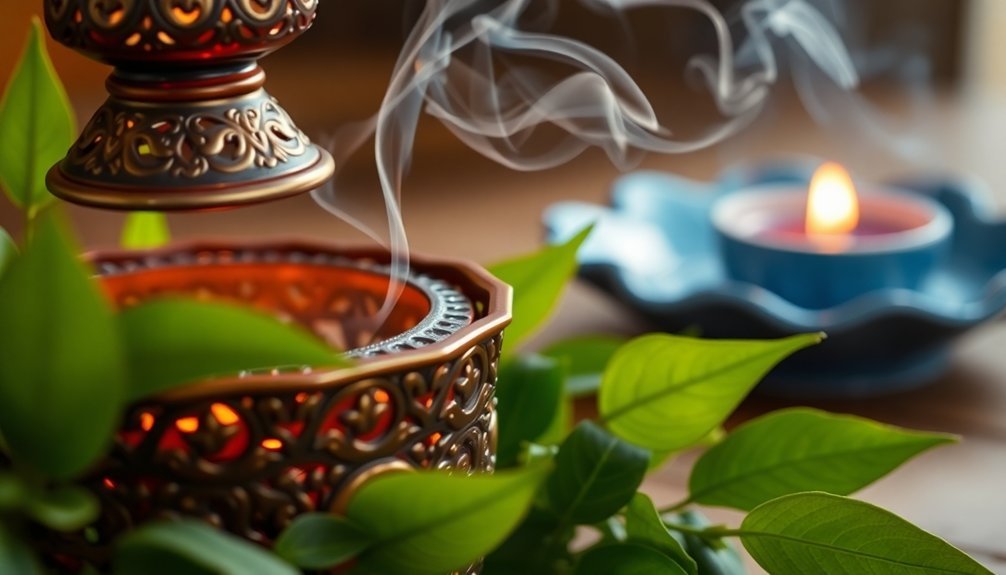
Creating a harmonious oriental fragrance requires careful consideration of both warm and cool notes to achieve the perfect balance.
You'll find that layering techniques can help you master this delicate art. Start by combining warm oriental base notes like amber, oud, and incense with cooler top notes such as citrus or herbs.
For seasonal adaptability, you can adjust your fragrance's intensity by varying the application method. During warmer months, apply your oriental scent lightly on pulse points, while in colder weather, you might layer it more generously.
Consider using an Eau de Parfum concentration for better longevity and depth.
When selecting ingredients, pair spices like cinnamon and ginger with lighter florals or citrus notes to create a well-rounded signature scent that works year-round.
The Science of Layering Oriental Fragrance Components
In your journey to master oriental fragrances, you'll notice how base notes like amber, vanilla, and musk create the longest-lasting foundation of your scent.
You can enhance these base notes by strategically layering complementary components, such as incense with spices or resins with woods.
The success of your layering technique depends on understanding how each component interacts with your body chemistry, creating a harmonious blend that evolves uniquely on your skin.
Base Notes Last Longest
The science behind base notes reveals why they're the most enduring components of Oriental fragrances. These foundational elements, including woods, resins, and musks, have complex molecular structures that bond exceptionally well with your skin's natural oils.
In winter, you'll notice these scents become even more pronounced as cool temperatures slow down their diffusion.
When you choose an Oriental fragrance, you're investing in these lasting base notes that will:
- Emerge gradually after top and heart notes fade, creating your signature scent
- Persist for hours or even days, especially if you have oily skin
- Provide a warm, sophisticated dry-down phase that's uniquely yours
Your body chemistry plays an essential role in how these base notes develop, making each Oriental fragrance a personal expression of your individual scent profile.
Harmony Through Multiple Components
Masterful Oriental fragrances achieve their distinctive character through an intricate layering of components that work in harmony.
When you wear these scents, you'll experience how the fresh top notes of citrus and lavender create your first impression, while middle notes of jasmine and rose add complexity to your signature fragrance.
The magic happens as base notes of vanilla and amber provide a lasting foundation, while exotic ingredients like oud, saffron, and incense weave through the composition.
You'll discover how spices like cardamom and cinnamon interact with woods such as sandalwood and cedar, creating a warm, meditative ambiance.
Rich resins like labdanum and benzoin enhance the perfume's longevity, while synthetic animal notes add a sensual depth that makes your scent uniquely memorable.
Seasonal Adjustments for Oriental Perfume Formulas
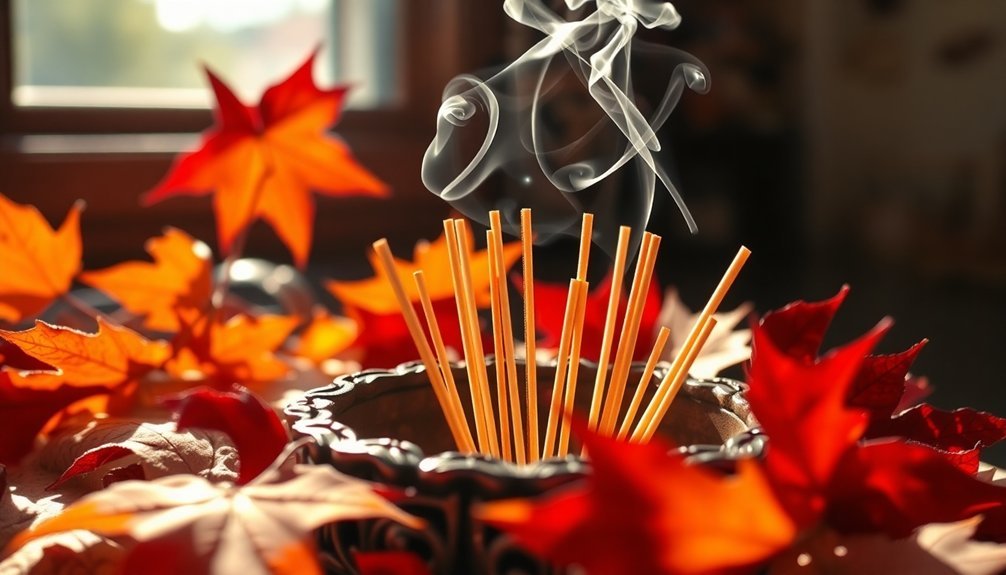
Adapting oriental perfume formulas to match each season's unique characteristics helps create a more harmonious and effective fragrance experience.
You'll want to shift from light, floral notes in spring to fresh, citrusy scents in summer, then change to warm, spicy aromas in autumn, and finally embrace rich, deep notes in winter.
Here's how to adjust your oriental fragrance throughout the year:
- Spring/Summer: Choose lighter concentrations like eau de toilette with jasmine, neroli, and citrus notes for a revitalizing feel.
- Autumn: Incorporate warm elements like vanilla, amber, and spices to match the season's cozy atmosphere.
- Winter: Opt for intense notes of musk, oud, and leather to create a luxurious, lasting presence in cold weather.
These seasonal adjustments guarantee your signature scent remains appropriate and impactful year-round.
Storage and Aging Tips for Oriental Perfume Blends
Proper storage techniques play an essential role in preserving your oriental perfume's complex notes and extending its shelf life. To maintain the rich blend of spices, resins, and woods in your oriental fragrance, store it in a cool, dark place between 15-20°C (59-68°F).
You'll want to keep your perfume in its original opaque bottle and box, which provide vital protection against light degradation.
Don't store your oriental blend in the bathroom, where humidity can alter its composition, or near sunny windows where UV rays can break down the volatile aromatic compounds. Instead, choose a temperature-controlled closet or basement.
For daily use, transfer small amounts into a travel-sized spray bottle, keeping your main bottle sealed and protected. This approach helps preserve the intense, exotic notes that make oriental perfumes so distinctive.
Measuring and Scaling Your Oriental Incense Recipe
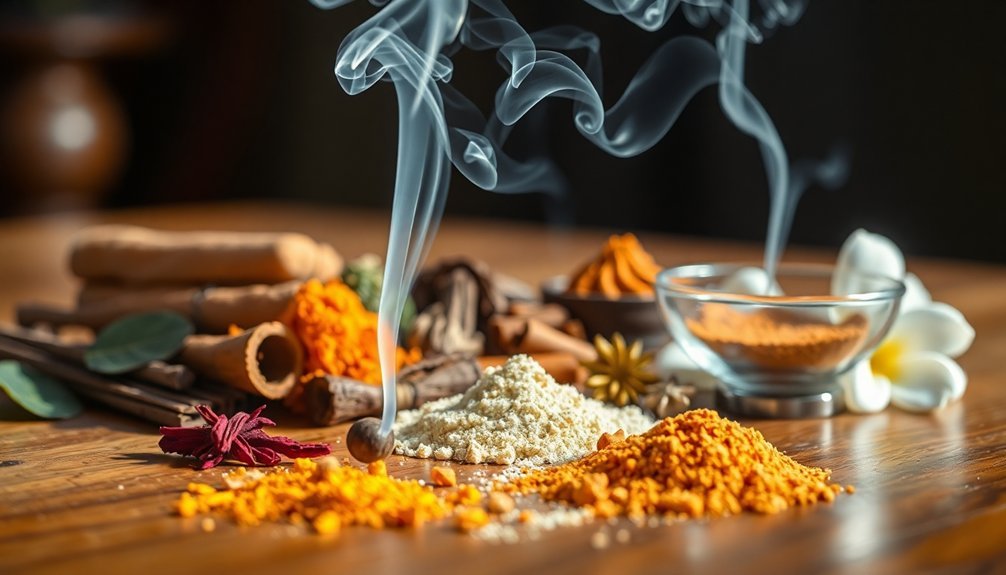
When you're crafting your signature Oriental incense blend, you'll need to master the basic ratios of resins (40%), woods (30%), and herbs (30%) while considering your room size for ideal scent diffusion.
You can adjust these proportions by measuring ingredients precisely with a gram scale, starting with smaller test batches of 10-15 grams total.
Your carefully measured blends will maintain their aromatic properties for up to two years when stored in airtight containers away from light and heat.
Basic Ratios For Ingredients
Three essential ratios form the backbone of any oriental incense recipe: base powders at 60%, binders at 25%, and aromatic components at 15%.
You'll want to carefully weigh these ingredients using a precise scale rather than relying on volume measurements, as this guarantees consistency in your final product.
When working with these ratios, remember these key points:
- Your base powder, typically sandalwood or nanmu, provides the foundation and primary burning characteristics.
- The binder, usually nanmu or tabu no ki powder, helps hold everything together and affects how well your incense burns.
- Your aromatic components, split between secondary scents (10%) and enhancers (5%), give your incense its distinctive character.
These proportions aren't just arbitrary – they're based on centuries of tradition and guarantee your incense burns properly while delivering the intended fragrance.
Storage And Shelf Life
Storage practices can make or break your oriental incense's longevity and aromatic potency. You'll want to keep your incense in a cool, dry, and dark place, away from direct sunlight and strong odors that could contaminate its fragrance.
Always maintain your incense in its original packaging, especially if it's made of kiri wood, which naturally protects against moisture. If you're organizing multiple types, use separate drawers or containers to prevent scent cross-contamination.
It's best to group similar fragrances together and label them clearly for easy identification.
Don't store your incense in basements or near heating vents. Instead, choose ground-level storage with good air circulation, preferably in an air-conditioned space.
If you're serious about preservation, consider investing in a kiri wood tansu for ideal storage conditions.
Adjusting For Room Size
Creating the perfect incense experience requires careful consideration of your room's dimensions. You'll need to measure your space's volume and account for ventilation to achieve the ideal aromatic balance.
For larger rooms, you'll want to increase your incense quantity by 10-20% for every additional 10 square meters.
For precise measurements and superior results, follow these key steps:
- Use a scale that measures to 0.01 grams when weighing your ingredients, ensuring consistency in your recipe.
- Select stronger aromatic materials like aloeswood or sandalwood when burning incense in spacious areas.
- Position your incense strategically by creating a hole in the ash for even heat distribution and proper aroma diffusion.
Remember to adjust your recipe based on room occupancy and activity levels to maintain the perfect scent intensity.
Troubleshooting Common Oriental Blend Challenges
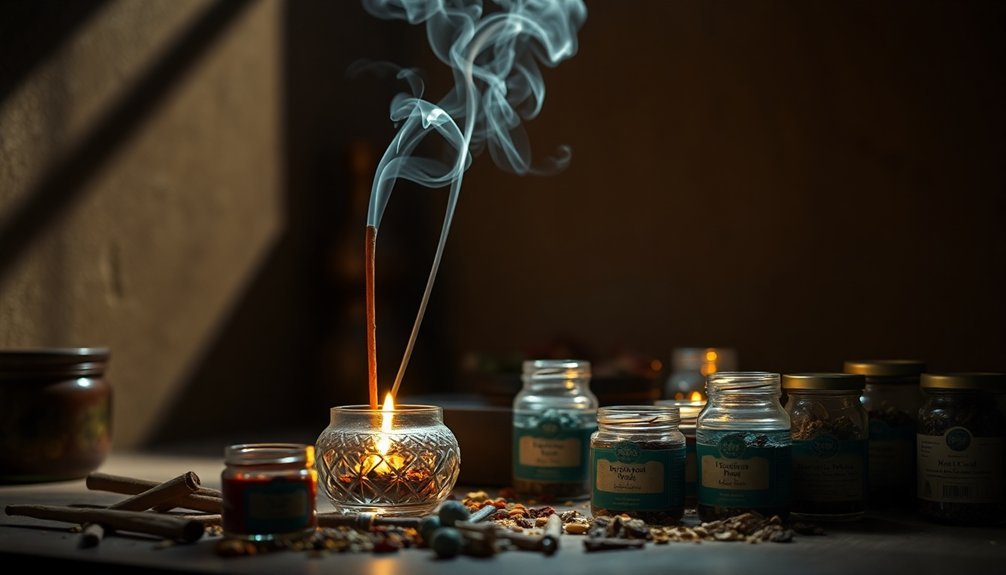
When blending and burning oriental incense, you'll likely encounter several common challenges that can affect the quality of your experience.
First, make sure you're distributing the powder evenly in your mold, especially in curved areas, to prevent premature burn-outs. You'll need to practice gentle tapping techniques to achieve the right consistency.
Your ash preparation is essential too. Fill your holder three-quarters full with white ash, stir clockwise with chopsticks, and use proper pressing techniques: right hand presses while left hand rotates.
Don't skip any spots during pressing.
If you're noticing overwhelming smoke, consider your room's conditions. Small or dry spaces can intensify smoke, so you'll want to burn your incense in well-ventilated, larger areas.
Remember that even premium ingredients won't perform well if not processed correctly or burned under ideal conditions.
Frequently Asked Questions
Can Oriental Incense Trigger Allergies or Respiratory Sensitivities?
Yes, you'll likely experience allergies or respiratory issues from oriental incense smoke. It contains irritants and toxins that can trigger asthma, cause allergic reactions, and worsen existing respiratory conditions you might have.
How Long Does Oriental Incense Typically Last on Skin?
You'll find oriental incense lasting 8-12 hours on your skin, with ingredients like oud and amber lingering even longer. Your skin's natural oils and proper application to pulse points enhance its longevity considerably.
Are There Synthetic Alternatives to Rare Oriental Incense Ingredients?
Yes, you'll find synthetic alternatives for rare oriental incense ingredients, but they're typically made with petroleum-based chemicals. While cheaper and more accessible, they lack the authentic fragrance profile and may pose health risks.
What's the Best Way to Remove Oriental Incense Scent From Clothes?
To remove incense smell from clothes, you'll want to wash them separately with regular detergent and 1/2 cup vinegar. Air-dry outside if possible, and use baking soda as a pre-treatment for stubborn scents.
Can Pregnant Women Safely Use Oriental Incense Products?
You shouldn't use oriental incense while pregnant. The smoke contains harmful chemicals like CO, VOCs, and particulate matter that can affect fetal development, potentially leading to lower birth weights and health issues.
In Summary
You'll find that oriental incense notes become more than just a fragrance—they're an extension of your identity. As you master the art of blending and aging these distinctive scents, you're creating a signature aroma that's uniquely yours. Whether you're adjusting formulas for seasons or fine-tuning measurements, your personal oriental perfume journey transforms into a lifelong passion that others will instantly recognize as unmistakably you.
References
- https://www.pairfum.com/oriental-perfume-a-journey-through-balsamic-scentscapes/
- https://shamtam.com/blogs/magazine/the-art-of-chinese-incense-a-journey-through-tradition-and-aromas
- https://habibiny.com/blogs/article/what-i-wish-everyone-knew-about-oriental-fragrance
- https://asianartnewspaper.com/the-history-of-incense-in-east-asia/
- https://setaracosmetics.it/blogs/fragrant-journeys/oriental-vs-western-fragrances-discover-what-sets-them-apart
- https://www.ahmedalmaghribi.com/ksa/how-oriental-notes-like-oud-and-incense-transform-any-perfume-into-pure-luxury/
- https://en.wikipedia.org/wiki/Incense_in_China
- https://parfumsnajmi.com/blogs/infos/exploring-the-science-behind-oriental-fragrances
- https://arabian-luxperfumes.com/en/why-oriental-scents-are-the-epitome-of-luxury-in-perfumery/
- https://merveperfumes.us/blogs/beyond-the-bottle/oriental-perfumes-modern-trends

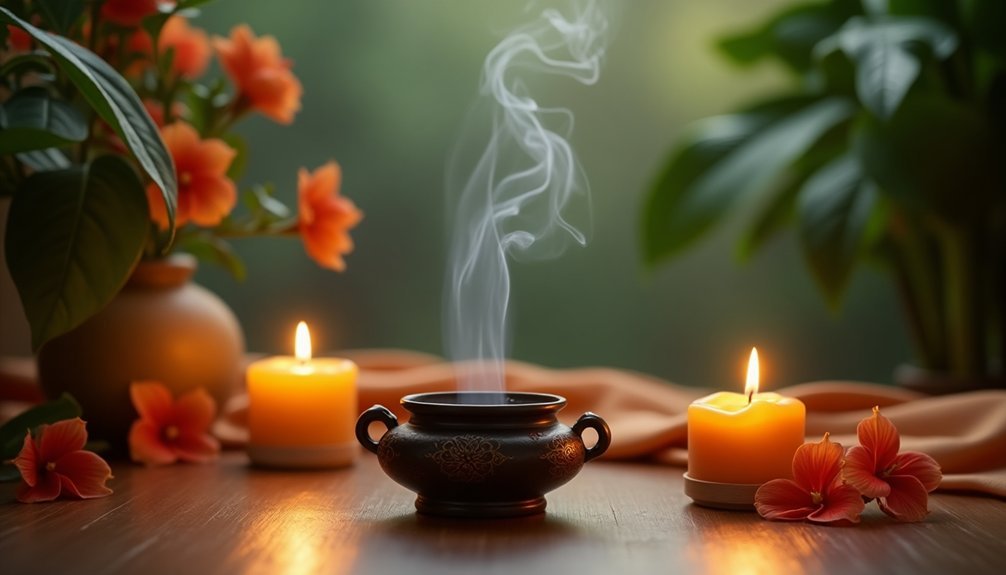



Leave a Reply